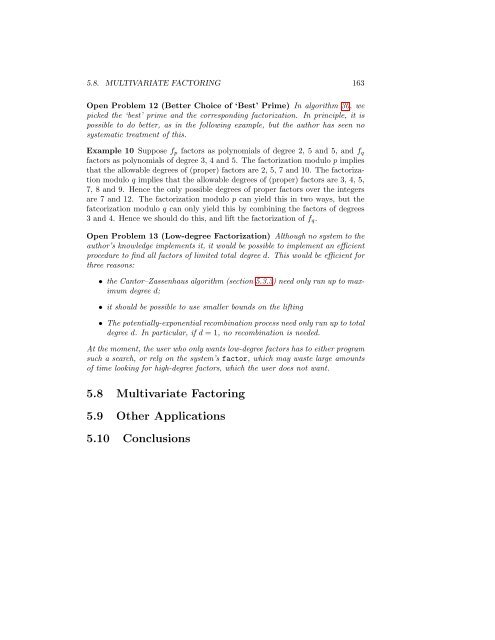Contents - Student subdomain for University of Bath
Contents - Student subdomain for University of Bath
Contents - Student subdomain for University of Bath
Create successful ePaper yourself
Turn your PDF publications into a flip-book with our unique Google optimized e-Paper software.
5.8. MULTIVARIATE FACTORING 163<br />
Open Problem 12 (Better Choice <strong>of</strong> ‘Best’ Prime) In algorithm 30, we<br />
picked the ‘best’ prime and the corresponding factorization. In principle, it is<br />
possible to do better, as in the following example, but the author has seen no<br />
systematic treatment <strong>of</strong> this.<br />
Example 10 Suppose f p factors as polynomials <strong>of</strong> degree 2, 5 and 5, and f q<br />
factors as polynomials <strong>of</strong> degree 3, 4 and 5. The factorization modulo p implies<br />
that the allowable degrees <strong>of</strong> (proper) factors are 2, 5, 7 and 10. The factorization<br />
modulo q implies that the allowable degrees <strong>of</strong> (proper) factors are 3, 4, 5,<br />
7, 8 and 9. Hence the only possible degrees <strong>of</strong> proper factors over the integers<br />
are 7 and 12. The factorization modulo p can yield this in two ways, but the<br />
fatcorization modulo q can only yield this by combining the factors <strong>of</strong> degrees<br />
3 and 4. Hence we should do this, and lift the factorization <strong>of</strong> f q .<br />
Open Problem 13 (Low-degree Factorization) Although no system to the<br />
author’s knowledge implements it, it would be possible to implement an efficient<br />
procedure to find all factors <strong>of</strong> limited total degree d. This would be efficient <strong>for</strong><br />
three reasons:<br />
• the Cantor–Zassenhaus algorithm (section 5.3.3) need only run up to maximum<br />
degree d;<br />
• it should be possible to use smaller bounds on the lifting<br />
• The potentially-exponential recombination process need only run up to total<br />
degree d. In particular, if d = 1, no recombination is needed.<br />
At the moment, the user who only wants low-degree factors has to either program<br />
such a search, or rely on the system’s factor, which may waste large amounts<br />
<strong>of</strong> time looking <strong>for</strong> high-degree factors, which the user does not want.<br />
5.8 Multivariate Factoring<br />
5.9 Other Applications<br />
5.10 Conclusions












![[Luyben] Process Mod.. - Student subdomain for University of Bath](https://img.yumpu.com/26471077/1/171x260/luyben-process-mod-student-subdomain-for-university-of-bath.jpg?quality=85)



